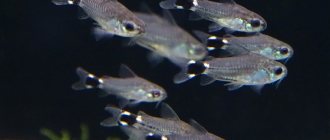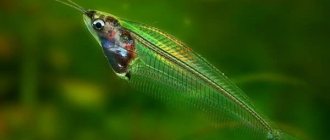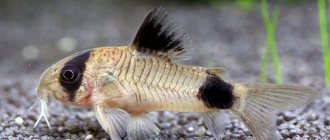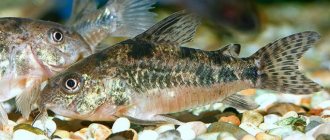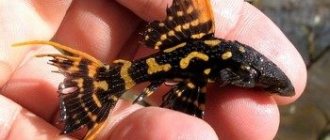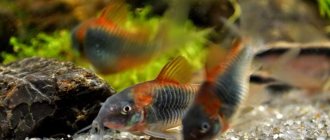Emerald catfish (Latin Corydoras splendens, English Emerald catfish) is a contented large species of Corydoras catfish. In addition to its size, it is distinguished by its bright green color. This is a relatively new species and its etymology is not simple.
Firstly, at least there is one more very similar catfish - Britski's catfish (Corydoras britskii) with which it is constantly confused.
In addition, in Russian there are many different names for it - emerald catfish, emerald catfish, green catfish, giant corydoras, etc. And these are just the well-known ones, because every seller on the market calls it differently.
Secondly, the catfish previously belonged to the now abolished genus Brochis and had a different name. It was then classified as a Corydoras, but the name Brochis is still found and can be considered a synonym.
Habitat in nature
The species was first described by Francis Louis Nompart de Caumont de Laporte, Comte de Castelnau in 1855.
The name comes from the Latin splendens, which means “shining, sparkling, brilliant, brilliant, bright, brilliant.”
More widespread than other types of corydoras. It is found throughout the Amazon basin, in Brazil, Peru, Ecuador and Colombia.
This species prefers to stay in places with little current or standing water, such as creeks and lakes. Water parameters in such places: temperature 22–28 °C, 5.8–8.0 pH, 2–30 dGH. They feed on various insects and their larvae.
It is possible that several different catfish are classified as this species, since they have not yet been reliably classified. Today there are two very similar catfish - Corydoras britskii and Brochis multiradiatus.
Maintenance and care
Green Corydoras are not difficult to keep; they are quite hardy, so they are recommended for beginners. These are sociable fish and prefer to be in a school of their own species. It is better to keep them in a group of 6 individuals, and preferably 10 or more. If you keep them alone, they will be shy and fearful.
For one fish, 75 liters of water is enough, but to keep a group of catfish you need an aquarium of 115 liters or more.
It is advisable to arrange the aquarium as a natural habitat: a lot of snags and branches, living plants, caves and other places for shelter. The soil should be smooth and soft so as not to damage the antennae - green brochis will actively rummage in it.
Although green corydoras tolerate oxygen-poor water well, it is recommended to use a powerful filter in the aquarium to saturate the water with oxygen. Keep an eye on your pets: if they rise to the surface too often to take a sip of water, then there is very little oxygen in the water.
Lighting does not play a special role if there are many places for shelter.
Temperature : 20 – 28 ° C; pH : 5.8-8.0; General hardness : 2 - 15 dGH.
Weekly water changes of 10% to 20% are required, with a siphon on the bottom of the aquarium, removing all waste.
Keeping in an aquarium
The ideal substrate is fine sand in which catfish can burrow. But, not large gravel with smooth edges will do. The choice of the rest of the decor is a matter of taste, but it is desirable that there are shelters in the aquarium.
This is a peaceful and unpretentious fish, the keeping of which is similar to that of most corydoras. They are shy and timid, especially if kept alone or in pairs. It is highly advisable to keep them in a flock of at least 6-8 individuals.
Emerald catfish prefer clean water with plenty of dissolved oxygen and plenty of food on the bottom. Accordingly, a good external filter will not be superfluous.
Be careful when netting these fish. When they feel threatened, they extend their sharp, spiny fins outward and lock them in a rigid position. The spines are quite sharp and can pierce the skin.
In addition, these spikes can cling to the fabric of the net and it will not be easy to shake the catfish out of it. It is better to catch them using a plastic container.
The optimal water parameters are similar to those in which Brochis lives in nature and are described above.
Description
Shiny corydoras grow up to 7-8.5 cm in length; females can reach 9 cm. In a home aquarium, with good care, they can live 13 years. Their main difference from other species of corydoras is the ten rays in the dorsal fin, while other species have seven.
The body of the fish is covered with bony plates along its entire length. There are 6 pairs of antennae around the mouth and strong, hard spines on the dorsal and pectoral fins. Corydoras emerald may produce sounds when disturbed or during courtship. The sounds are produced by the friction of the pectoral fins in the grooves.
The emerald catfish's muzzle is sharper and its body is thicker than that of other corydoras species.
The body of the fish is emerald green with a metallic sheen; depending on the lighting, it may appear blue.
Feeding
A bottom-dwelling fish that takes food exclusively from the bottom. Unpretentious, they eat all types of live, frozen and artificial food. Special pellets for catfish eat well.
You need to understand that catfish are not orderlies who finish eating after other fish! This is a fish that needs proper feeding and time to collect food. If they get crumbs from someone else’s feast, then don’t expect anything good.
Monitor feeding and if you see that the Corydoras remain hungry, feed before or after the end of daylight hours.
Reproduction
Spawning is most often stimulated with hormonal drugs, but this can also be achieved naturally. The spawning tank is required to be small, 40 liters per pair of fish. The optimal distribution would be 2 males to 1 female. The water temperature rises to 27 °C, which should stimulate spawning. If everything went smoothly, the female spawns about 300 eggs. Immediately after this, it is necessary to remove the breeder fish from the spawning tank. A week later, larvae appear from the eggs, and after a couple of days, full-fledged fry. They are fed with live dust, dry food, and brine shrimp.
Conditions of detention
The volume of the aquarium is selected at the rate of 30 liters per individual. Moreover, they will be most comfortable in a flock of 5-8 individuals. They will need intensive aeration and good filtration; Every week it is recommended to change about 1/5 of the water volume in the aquarium. These fish, unlike their fellow Corydoras, are active during the daytime and tolerate relatively bright lighting well. The soil should be fine-grained, without sharp edges, otherwise the catfish may be injured. It is desirable to have dense thickets of plants and various shelters.
Breeding/reproduction
Determining sex by external signs is extremely difficult, but when kept in a group, the probability of having at least one female and male increases sharply, so you will not have to choose partners separately. For a novice aquarist, breeding these catfish is problematic, since it is difficult to reproduce all the necessary conditions in a home aquarium. Catfish breed during the rainy season, so to start spawning it is necessary to lower the water temperature a couple of degrees. The female lays 900 to 1,100 eggs, attaching them to rocks, plants and other objects. The eggs are susceptible to fungal infections, so antifungal drugs should be used during egg laying.
Emerald Brochis
Emerald catfish (Latin Corydoras splendens, English Emerald catfish) is a contented large species of Corydoras catfish. In addition to its size, it is distinguished by its bright green color. This is a relatively new species and its etymology is not simple.
Firstly, at least there is one more very similar catfish - Britski's catfish (Corydoras britskii) with which it is constantly confused.
In addition, in Russian there are many different names for it - emerald catfish, emerald catfish, green catfish, giant corydoras, etc. And these are just the well-known ones, because every seller on the market calls it differently.
Secondly, the catfish previously belonged to the now abolished genus Brochis and had a different name. It was then classified as a Corydoras, but the name Brochis is still found and can be considered a synonym.
Content
- Other names: Brochis splendens.
- Origin: Brazil, Peru, Ecuador.
- Size: up to 9 cm.
- Temperature: 20-22 °C.
- Water parameters: pH 6.8–7.2, dkH 8–10.
- Behavior: active during the day, peaceful, gregarious.
- Content difficulty: medium.
Brohis
Brochis green
Order, family: armored catfish.
Comfortable water temperature: 22-26° C.
Ph: 6-8.
Aggressiveness: not aggressive.
Compatibility: any fish. The only things that are not desirable are Labeo and Botia Modesta, because they chase them (although it's more like a game).
Synonyms: emerald catfish, green corydoras.
Description: The homeland of brochis or green catfish is Peru and northern Brazil. Length up to 9 cm. Because of their similarity, they are often called corridors .
The head of the fish is large, the body is high in front, gradually lowers towards the tail, the sides are flattened. The color of the fish is emerald greenish with a shiny tint.
Fish slowly swim along the bottom in search of food. In an aquarium they are usually kept in a flock. The fish do not pose any threat to other inhabitants of the aquarium. They have additional intestinal respiration and often emerge from the water to capture air.
Brochis emerald
It is not difficult to keep these Brochis catfishes in an aquarium. It is advisable to use sand as soil. It is necessary to have a large number of shelters in the form of stones, snags or grottoes where fish can hide and rest.
Brohis Corydoras
Comfortable water parameters: 22-26°C, dH 5-25°, pH 6-8. Water filtration is required, it is advisable to change 1/4 of the water from the entire volume of the aquarium weekly. Fish are undemanding to the quality of aeration.
Emerald catfish feed on all kinds of food in the form of flakes and granules, and dry food. They only take food from the bottom. Feeding aquarium fish should be correct: balanced, varied. This fundamental rule is the key to the successful keeping of any fish, be it guppies or astronotuses. The article “How and how much to feed aquarium fish” talks about this in detail; it outlines the basic principles of the diet and feeding regime of the fish.
Brochis emerald
In this article, we note the most important thing - feeding fish should not be monotonous; the diet should include both dry food and live food. In addition, you need to take into account the gastronomic preferences of a particular fish and, depending on this, include in its diet food either with the highest protein content or, conversely, with plant ingredients.
Popular and popular food for fish, of course, is dry food. For example, you can constantly and everywhere find food on aquarium shelves - the leader of the Russian market; in fact, the range of food for this Tetra is included as individual food for a specific type of fish: for goldfish, for cichlids, for loricariids, guppies, labyrinths, arowanas, discus, etc. .d. Tetra has also developed specialized foods, for example, to enhance color, fortified, or for feeding fry. You can find out detailed information about all Tetra feeds on the company’s official website - here .
Emerald brochis, or emerald catfish Corydoras (Brochis) splendens
11936
Emerald Brochis video
The emerald catfish was first described by researcher Francois Castelnau in 1855. It came to Europe in the nineteenth century from Peru. These fish live in the reservoirs of Brazil, Peru, Ecuador, in the basin of the Ucayali, Maranon and Amazon rivers. They inhabit rivers, tributaries and reservoirs with standing water, living in shallow water with silty soil and dense vegetation. Catfish stay in schools, prefer shallows with oxygen-enriched water, but if necessary they can rise to the surface for a breath of air. They can breathe atmospheric air because they have an additional intestinal respiratory organ. In nature, the emerald catfish reaches a length of 8-9 cm, but in an aquarium they do not grow more than 6 cm.
The emerald catfish has a large head with a relatively high body, which gradually slopes down to the tail. The flat sides of the fish are covered with two rows of hard plates, which perform a protective function against attacks by predatory fish. The sides of the fish are a shiny greenish color, the belly is bright yellow, and the back is pale brown with a slight hint of green. Males differ from females by having pointed dorsal fins. In addition, they are smaller in size and their abdomens are less rounded than those of females.
These catfish are schooling fish; it is advisable to keep several in one aquarium. To keep 3-5 individuals, a 50-liter aquarium, decorated with plants, driftwood, stones or grottoes, will be sufficient. The soil used is loose, soft, without sharp edges, as catfish can damage their antennae, and this will complicate the search for food. Coarse sand or small pebbles are good for this.
In their natural habitat, the main food sources for emerald catfish are worms, insects, small crustaceans and plants. In aquariums, the diet of catfish can include live and frozen food: daphnia, brine shrimp, bloodworms, etc., as well as dry food, tablets and granules for catfish.
Emerald brochis become sexually mature at the age of about a year. They spawn in groups. As a spawning aquarium, an aquarium with a volume of about 40 liters per pair of fish is required. In nature, catfish breed during the rainy season, so to stimulate spawning it is necessary to lower the water temperature by a couple of degrees. The female can lay 900 to 1,100 eggs, attaching them to rocks, plants and other objects. The eggs develop from 4 to 12 days. The fry and juveniles are completely different from their parents - they are brownish with spots on the body and a particularly large reddish-brown dorsal fin.
